American film actress Jean Harlow (1911–1937) was with her come-hither body, platinum blonde hair, and keen sense of humour, one of Hollywood's sex symbols of the 1930s. She had her breakthrough in Howard Hughes' World War I epic Hell's Angels (1930). Frank Capra's Platinum Blonde (1931) cemented her role as America's new sex symbol. In 1932, she signed with Metro-Goldwyn-Mayer and became the leading lady in a string of hit films. These included Red Dust (1932), Dinner at Eight (1933), Reckless (1935) and Suzy (1936). Among her frequent co-stars were William Powell, Spencer Tracy and, in six films, Clark Gable.
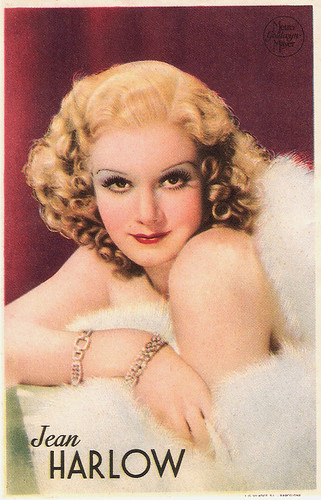
Spanish collector's card by J.G. Viladot, Barcelona. Photo: Metro-Goldwyn Mayer.
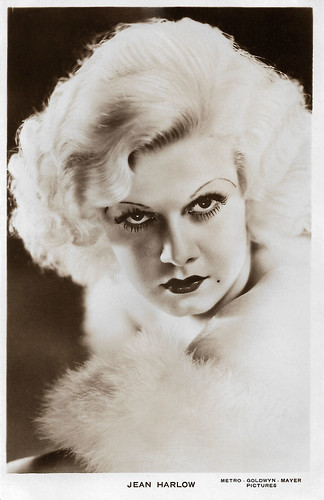
British Real Photograph postcard. Photo: Metro-Goldwyn-Mayer.
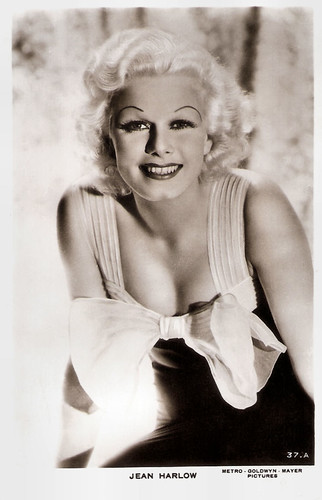
British Real Photograph postcard, no. 37 A. Photo: Metro-Goldwyn-Mayer.

British postcard in the Picturegoer Series, London, no. 712b. Photo: Metro Goldwyn Mayer.

British postcard by De Reszke Cigarettes, no. 6. Photo: M.G.M.

British postcard by De Reszke Cigarettes, no. 16. Photo: M.G.M.
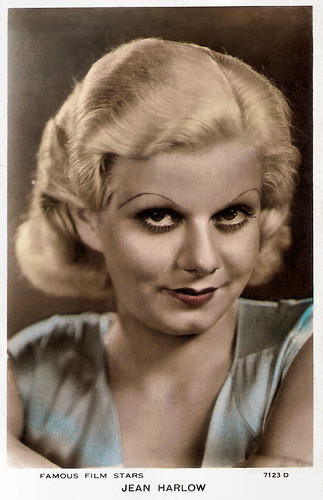
British Real Photograph postcard by Valentine's in the Famous Film Stars series, no. 7123 D. Photo: Metro-Goldwyn-Mayer.
Jean Harlow was born Harlean Harlow Carpenter in Kansas City, Missouri, in 1911. The name is sometimes incorrectly spelt Carpentier, following later studio press releases. Her father, Mont Clair Carpenter was a dentist from a working-class background who attended dental school in Kansas City. Her mother, Jean Poe Carpenter née Harlow was the daughter of a wealthy real estate broker, Skip Harlow. The marriage was arranged by Jean's father for their underage daughter in 1908. Jean was resentful and became very unhappy in the marriage. The couple lived in Kansas City in a house owned by Jean's father. Harlean was nicknamed 'The Baby', a name that would stick with her for the rest of her life. Harlean and 'Mother Jean', as she became known when Harlean became a film star, remained very close. Harlean's mother was extremely protective and coddling, reportedly instilling a sense that her daughter owed everything she had to her. "She was always all mine", she said of her daughter. When Harlean was at school, her mother filed for a divorce that was finalised in 1922. She was granted sole custody of Harlean, who loved her father. He would survive her by thirty-seven years. However, Harlean would rarely see him again. Mother Jean moved with Harlean to Hollywood in 1923 with hopes of becoming an actress but was too old at 34 to begin a film career. Young Harlean attended the Hollywood School for Girls but dropped out at age 14 in the spring of 1925. Finances dwindling, she and her mother moved back to Kansas City after Skip Harlow issued an ultimatum that he would disinherit Jean if she did not return. Several weeks later, Skip sent his granddaughter to a summer camp, Camp Cha-Ton-Ka, in Michigamme, Michigan, where she became ill with scarlet fever. Her mother travelled to Michigan to care for her, rowing across the lake to the camp but was told she could not see her daughter. Harlow attended the Ferry Hall School (now Lake Forest Academy) in Lake Forest, Illinois. Her mother had an ulterior motive for Harlean's attendance there, as it was close to the Chicago home of her boyfriend, Marino Bello. Each freshman was paired with a 'big sister' from the senior class, and Harlean's big sister introduced her to 19-year-old Charles 'Chuck' Fremont McGrew, heir to a large fortune, in the fall of 1926. Soon the two began to date and then married. In early 1927, Jean Carpenter married Bello; Harlean was absent.
Shortly after the wedding, the McGrews left Chicago and moved to Beverly Hills. McGrew turned 21 two months after the marriage and received part of his large inheritance. The couple moved to Los Angeles in 1928, settling into a home in Beverly Hills, where Harlean thrived as a wealthy socialite. McGrew hoped to distance Harlean from her mother with the move. Neither McGrew nor Harlean worked, and both, especially McGrew, were thought to drink heavily. In Los Angeles, Harlean befriended Rosalie Roy, a young aspiring actress. Lacking a car, Roy asked Harlean to drive her to Fox Studios for an appointment. Reputedly, Harlean was noticed and approached by Fox executives while waiting for her friend but stated that she was not interested. Nevertheless, she was given dictated letters of introduction to Central Casting. A few days later, Rosalie Roy bet Harlean that she did not have the nerve to go and audition. Unwilling to lose a wager and pressed by her enthusiastic mother, now back in Los Angeles, Harlean drove to Central Casting and signed in under her mother's maiden name, Jean Harlow. After several calls from Central Casting and several rejected job offers, Harlean was pressed into accepting work by her mother. She appeared in her first film, Honor Bound (Alfred E. Green, 1928), as an unbilled extra. This led to small parts in feature films such as Moran of the Marines (Frank R. Strayer, 1928) with Richard Dix, This Thing Called Love (Paul L. Stein, 1929), Close Harmony (John Cromwell, 1929), and The Love Parade (Ernst Lubitsch, 1929), starring Maurice Chevalier.
In December 1928, she signed a five-year contract with Hal Roach Studios for $100 per week. She had a co-starring role in Laurel and Hardy's short Double Whoopee (Lewis R. Foster, 1929), and went on to appear in two more of their films: Liberty (Leo McCarey, 1929) and Bacon Grabbers (Lewis R. Foster, 1929). In March 1929, however, she parted with Hal Roach, who tore up her contract after Harlow told him, "It's breaking up my marriage, what can I do?" In June 1929, Harlow separated from her husband and moved in with her mother and Bello. After her separation from McGrew, Harlow worked as an extra in several films. She landed her first speaking role in The Saturday Night Kid (A. Edward Sutherland, 1929), starring Clara Bow. The couple divorced in 1929. In late 1929, Jean was spotted by actor James Hall, who was filming Howard Hughes' Hell's Angels (1930). Hughes revamped most of his originally silent film of 1927 with sound, and he needed an actress to replace Greta Nissen, who had a Norwegian accent that was considered to be undesirable for her character. Harlow made a test and got the part. In this film she uttered the immortal words "Would you be shocked if I changed into something more comfortable?" Hughes signed Harlow to a five-year, $100-per-week contract in 1929. Hell's Angels premiered in Hollywood on 27 May 1930, at Grauman's Chinese Theater, becoming the highest-grossing film of 1930, besting even Greta Garbo's talkie debut in Anna Christie (Clarence Brown, 1930).
Hell's Angels (Howard Hughes, Edmund Goulding, James Whale, 1930) made Harlow an international star. Although she was popular with audiences, critics were less than enthusiastic. The New Yorker called her performance "plain awful", though Variety magazine conceded, "It doesn't matter what degree of talent she possesses ... nobody ever starved possessing what she's got." During the shooting, Harlow met MGM executive Paul Bern. She was again an uncredited extra in the Charlie Chaplin film City Lights (1931), though her appearance did not make the final cut. With no projects planned for Harlow, Hughes sent her to New York, Seattle, and Kansas City for Hell's Angels premieres. In 1931, loaned out by Hughes to other studios, she gained more attention when she appeared in The Secret Six (George W. Hill, 1931), with Wallace Beery and Clark Gable; Iron Man (Tod Browning, 1931), with Lew Ayres and Robert Armstrong; and The Public Enemy (William A. Wellman, 1931), with James Cagney. Though the successes of the films ranged from moderate to hit, Harlow's acting was mocked by critics. Concerned, Hughes sent her on a brief publicity tour, which was not a success, as Harlow dreaded such personal appearances. Jean Harlow dated notorious New Jersey mobster Abner Zwillman (aka 'Longy"), who secured a two-picture deal for her with Harry Cohn of Columbia Pictures by loaning Cohn $500,000 in cash. He also purchased her a jewelled charm bracelet and a red Cadillac.
Columbia Pictures cast her in Platinum Blonde (Frank Capra, 1931), with Loretta Young. The film, originally titled Gallagher, was renamed to promote Harlow, capitalising on her hair colour, called 'platinum' by Hughes' publicists. Though Harlow denied her hair was dyed, the platinum blonde colour was reportedly achieved by bleaching with a weekly application of ammonia, Clorox bleach, and Lux soap flakes. This process weakened and damaged Harlow's naturally ash-blonde hair. Many female fans began dyeing their hair to match hers. Howard Hughes' team organised a series of 'Platinum Blonde' clubs across the nation, with a prize of $10,000 to any beautician who could match Harlow's shade. No one could, the prize went unclaimed but Hughes' publicity worked and the nickname stuck with Harlow. Harlow next filmed Three Wise Girls (William Beaudine, 1932), for Columbia Pictures, with Mae Clark and Walter Byron. Paul Bern then arranged to borrow her for The Beast of the City (1932), co-starring Walter Huston. After filming, Bern booked a 10-week personal appearance tour on the East Coast. To the surprise of many, especially Harlow herself, she packed every theatre in which she appeared, often appearing in a single venue for several nights. Despite critical disparagement and poor roles, Harlow's popularity and following were large and growing and, in February 1932, the tour was extended by six weeks.

Italian postcard by Cinema-Illustrazione, no. 12, Serie II. Photo: United Artists. Ben Lyon and Jean Harlow in Hell's Angels (Howard Hughes, 1930).
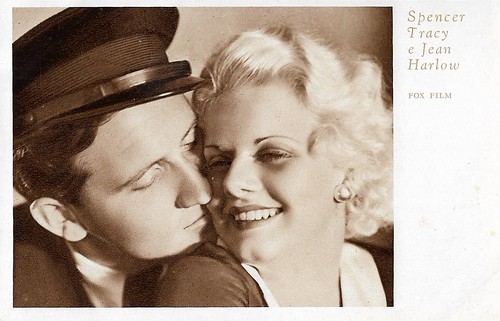
Italian postcard by Cinema-Illustrazione, series 2, no. 36. Spencer Tracy and Jean Harlow in Goldie (Benjamin Stoloff, 1931), a remake of Howard Hawks' silent film A Girl in Every Port (1928).

Dutch postcard, no. 513. Photo: M.G.M. Jean Harlow and Clark Gable in Red Dust (Victor Fleming, 1932). Sent by mail in 1935.

British postcard by Film Weekly. Photo: MGM. Jean Harlow and Franchot Tone in the pre-Code screwball comedy Blonde Bombshell/Bombshell (Victor Fleming, 1933).
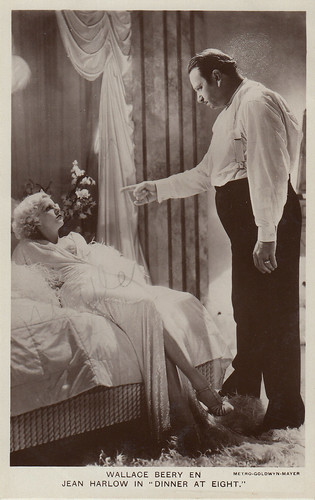
Dutch postcard by M. Bonnist & Zonen, no. B335. Photo: M.G.M. Jean Harlow and Wallace Beery in Dinner at Eight (George Cukor, 1933). Collection: Marlene Pilaete.

Dutch postcard by M. Bonnist & Zonen, Amsterdam, no. B 447. Photo: M.G.M. Jean Harlow and Clark Gable in China Seas (Tay Garnett, 1935). Collection: Marlene Pilaete.

Dutch postcard, no. 437. Photo: Metro-Goldwyn-Mayer.
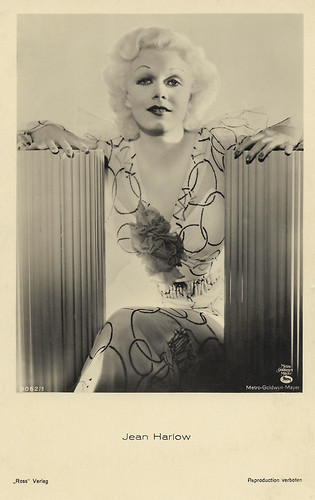
German postcard by Ross Verlag, no. 9062/3, 1935-1936. Photo: Metro-Goldwyn-Mayer.

German postcard by Ross Verlag, no. A 1207/1, 1937-1938. Photo: Metro Goldwyn Mayer. Jean Harlow and Robert Taylor in Personal Property (W.S. Van Dyke, 1937).
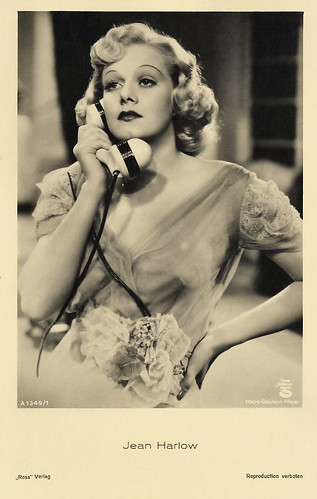
German postcard by Ross Verlag, no. A 1349/1, 1937-1938. Photo: Metro-Goldwyn-Mayer. Publicity still for Saratoga (Jack Conway, 1937).
Jean Harlow was now romantically involved with MGM producer Paul Bern and he spoke to Louis B. Mayer about buying out her contract with Hughes and signing her to MGM, but Mayer declined. MGM's leading ladies were presented as elegant, while Harlow's 'floozy' screen persona was abhorrent to Mayer. Bern then began urging close friend Irving Thalberg, production head of MGM, to sign Harlow, noting her popularity and established image. After initial reluctance, Thalberg agreed and, on 3 March 1932, Harlow's 21st birthday, Bern called her with the news that MGM had purchased her contract from Hughes for $30,000. At MGM, Harlow was given superior movie roles to show off her looks and nascent comedic talent. Though Harlow's screen persona changed dramatically during her career, one constant was her apparent sense of humour. In 1932, she starred in the comedy Red-Headed Woman (Jack Conway, 1932), for which she received $1,250 a week. The film is often noted as being one of the few films in which Harlow did not appear with platinum blonde hair; she wore a red wig for the role. She next starred in Red Dust (Victor Fleming, 1932), her second film with Clark Gable. Harlow and Gable worked well together and co-starred in a total of six films.
She was also paired multiple times with Spencer Tracy and William Powell. At this point, MGM began trying to distinguish Harlow's public persona from that of her screen characters, changing her childhood surname from common 'Carpenter' to chic 'Carpentier', claiming that writer Edgar Allan Poe was one of her ancestors and publishing photographs of Harlow doing charity work to change her image from that of a tramp to an all-American girl. This transformation proved difficult; once, Harlow was heard muttering, "My God, must I always wear a low-cut dress to be important?" During the making of Red Dust, Paul Bern — her husband of two months — was found dead at their home. His death created a lasting scandal. Initially, Harlow was speculated to have killed Bern, but Bern's death was officially ruled a suicide by a self-inflicted gunshot wound. Reportedly, the day after Bern's former common-law wife met Harlow, Bern shot himself. A few days later former Mrs. Bern was found floating in the Sacramento River, after allegedly committing suicide. Louis B. Mayer feared negative publicity from the incident and intended to replace Harlow in the film, offering the role to Tallulah Bankhead. Bankhead was appalled by the offer and wrote in her autobiography, "To damn the radiant Jean for the misfortune of another would be one of the shabbiest acts of all time. I told Mr. Mayer as much." Harlow kept silent, survived the ordeal, and became more popular than ever. A 2009 biography of Bern asserted that Bern was, in fact, murdered by a former lover and the crime scene re-arranged by MGM executives to make it appear Bern had killed himself.
After Bern's death, Harlow began an indiscreet affair with boxer Max Baer who, though separated from his wife Dorothy Dunbar, was threatened with divorce proceedings naming Harlow as a co-respondent for "alienation of affection", a legal term for adultery. After Bern's mysterious death, the studio did not want another scandal and defused the situation by arranging a marriage between Harlow and cinematographer Harold Rosson. Rosson and Harlow were friends and Rosson went along with the plan. They quietly divorced eight months later. By 1933, MGM realised the value of the Harlow-Gable team and paired them again in Hold Your Man (Sam Wood, 1933), which was also a box-office success. The same year, she played the adulterous wife of a ruthless tycoon (Wallace Beery) in the glittering all-star comedy-drama Dinner at Eight (George Cukor, 1933), and played a pressured Hollywood film star in the screwball comedy Bombshell (Victor Fleming, 1933) with Lee Tracy. The film has often been cited as being based on Harlow's own life or that of the 1920s 'It Girl', Clara Bow. The film included Harlow's greedy stepfather, her nine-room Georgian-style home with mostly-white interiors, and her numerous pet dogs. The following year, she was teamed with Lionel Barrymore and Franchot Tone in The Girl from Missouri (Jack Conway, 1934). The film was the studio's attempt at softening Harlow's image, but suffered with censorship problems, so much so that its original title, Born to Be Kissed, had to be changed.
In 1934, Jean Harlow went on a salary strike from MGM, during which she wrote a novel, 'Today is Tonight'. The book was not published until 1965. After the financial success of Red Dust and Hold Your Man, MGM cast Harlow with Clark Gable in two more successful films: China Seas (Tay Garnett, 1935), with Wallace Beery and Rosalind Russell; and Wife vs. Secretary (Clarence Brown, 1936), with Myrna Loy and James Stewart. Jean Harlow's popularity rivalled and soon surpassed that of her MGM colleagues Joan Crawford and Norma Shearer. Reckless (Victor Fleming, 1935) was her first film musical. It co-starred her then-boyfriend William Powell and Franchot Tone. Suzy (George Fitzmaurice, 1936), in which she played the title role, gave her top billing over Franchot Tone and Cary Grant. While critics noted that Harlow dominated the film, they added that her performance was imperfect, and the film was a reasonable box-office success. She then starred in Riffraff (J. Walter Ruben, 1936) with Spencer Tracy and Una Merkel, a financial disappointment, and the worldwide hit Libeled Lady (Jack Conway, 1936), in which she was top billed over Powell, Myrna Loy, and Tracy.
By the late 1930s, Jean Harlow had become one of the biggest stars of Hollywood, often nicknamed the 'Blonde Bombshell' and the 'Platinum Blonde'. She filmed W.S. Van Dyke's comedy Personal Property (1937), co-starring Robert Taylor. It was Harlow's final fully completed film appearance. During the filming of Saratoga (Jack Conway, 1937), she died in 11 hospitals of renal failure at the age of 26. The official cause of death was 'uremic poisoning brought on by acute nephritis'. For many years it was a widely held belief that she died because her mother, a Christian Scientist, refused to let doctors operate on her after she became sick. This story has been repeatedly shown to be completely untrue. MGM closed on the day of her funeral, 9 June 1937. Saratoga was completed using doubles and released a little over a month after Jean Harlow's death. It became MGM's second-highest-grossing picture of 1937. In 1965, two films about Jean Harlow were released, both called Harlow. The first, Harlow (Alex Segal, 1965), was released by Magna in May 1965 and stars Carol Lynley with Ginger Rogers as Mama Jean. The second, Harlow (Gordon Douglas, 1965), was released in June by Paramount Pictures and stars Carroll Baker with Angela Lansbury as her mother. Both were poorly received and did not perform well at the box office.

French postcard by Editions Chantal (EC). Photo: Metro-Goldwyn-Mayer.

French postcard by Editions Chantal (EC), no. 30. Photo: Metro-Goldwyn-Mayer.

French postcard by CE (Cinémagazine-Édition, Paris), no. 2098. Photo: Metro-Goldwyn-Mayer.
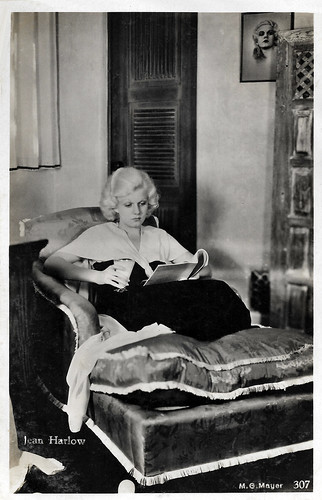
Dutch postcard by JosPe, Arnhem, no. 307. Photo: M.G.M.

Dutch postcard, no. 316. Photo: M.G.M.
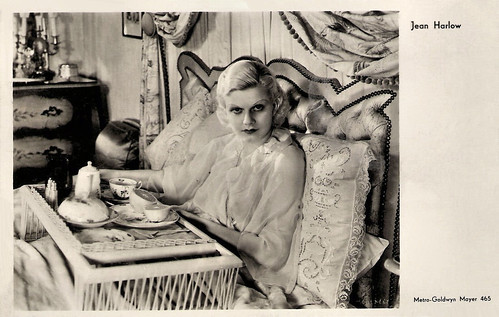
Dutch postcard, no. 465. Photo: Metro-Goldwyn-Mayer.

Dutch postcard, no. 483. Photo: M.G.M. Publicity still for Red Dust (Victor Fleming, 1932) with Clark Gable. Sent by mail in 1935.
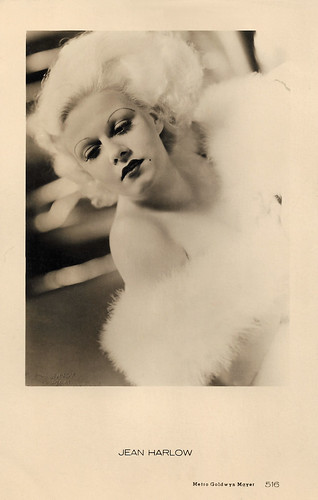
Dutch postcard, no. 516. Photo: M.G.M.

Dutch postcard, no. 631. Photo: Metro-Goldwyn-Mayer.
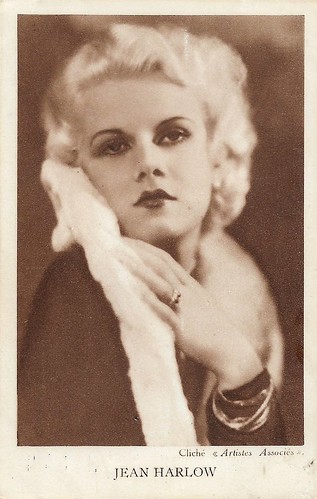
Belgian postcard by S. A. Cacao et Chocolat Kivou, Vilvorde / N. V. Cacao en Chocolade Kivou, Vilvoorde. Photo: United Artists. Publicity still for Hell's Angels (Howard Hughes, Edmund Goulding, James Whale, 1930).
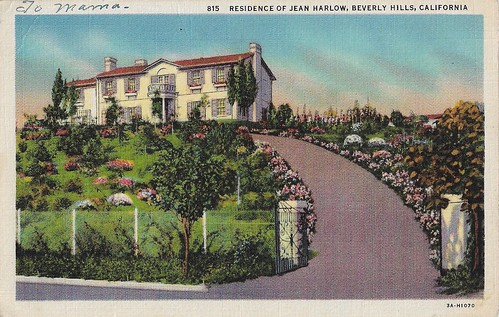
Jean Harlow residence, Beverly Hills. American postcard by Western Publishing & Novelty Co., Los Angeles, no. 815.

Swiss postcard by News Productions, Baulmes / Stroud, Filmwelt Berlin, bo. no. 56555. Photo: MGM / Collection Cinémathèqye Suisse, Lausanne. Clark Gable, Jean Harlow and Victor Fleming on the set of Red Dust (Victor Fleming, 1932).

French postcard in the Collection 'Portraits de Cinema (2nd Series, no. 23) by Editions Admira & Hollywood Photographers Archives. Photo: Metro Goldwyn Mayer. Jean Harlow in Dinner at Eight (George Cukor, 1933).

American postcard by Fotofolio, N.Y., N.Y., no. GH5. Photo: George Hurrell. Caption: Jean Harlow, 1934.
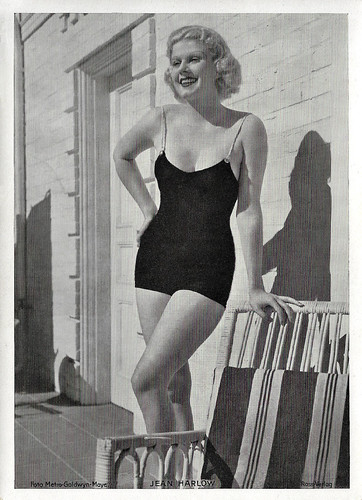
Big German card by Ross Verlag. Photo: Metro-Goldwyn-Mayer.
Sources: Sandra Brennan (AllMovie), Denny Jackson (IMDb), Ed Stephan (IMDb), Wikipedia and IMDb.

Spanish collector's card by J.G. Viladot, Barcelona. Photo: Metro-Goldwyn Mayer.

British Real Photograph postcard. Photo: Metro-Goldwyn-Mayer.

British Real Photograph postcard, no. 37 A. Photo: Metro-Goldwyn-Mayer.

British postcard in the Picturegoer Series, London, no. 712b. Photo: Metro Goldwyn Mayer.

British postcard by De Reszke Cigarettes, no. 6. Photo: M.G.M.

British postcard by De Reszke Cigarettes, no. 16. Photo: M.G.M.

British Real Photograph postcard by Valentine's in the Famous Film Stars series, no. 7123 D. Photo: Metro-Goldwyn-Mayer.
The baby
Jean Harlow was born Harlean Harlow Carpenter in Kansas City, Missouri, in 1911. The name is sometimes incorrectly spelt Carpentier, following later studio press releases. Her father, Mont Clair Carpenter was a dentist from a working-class background who attended dental school in Kansas City. Her mother, Jean Poe Carpenter née Harlow was the daughter of a wealthy real estate broker, Skip Harlow. The marriage was arranged by Jean's father for their underage daughter in 1908. Jean was resentful and became very unhappy in the marriage. The couple lived in Kansas City in a house owned by Jean's father. Harlean was nicknamed 'The Baby', a name that would stick with her for the rest of her life. Harlean and 'Mother Jean', as she became known when Harlean became a film star, remained very close. Harlean's mother was extremely protective and coddling, reportedly instilling a sense that her daughter owed everything she had to her. "She was always all mine", she said of her daughter. When Harlean was at school, her mother filed for a divorce that was finalised in 1922. She was granted sole custody of Harlean, who loved her father. He would survive her by thirty-seven years. However, Harlean would rarely see him again. Mother Jean moved with Harlean to Hollywood in 1923 with hopes of becoming an actress but was too old at 34 to begin a film career. Young Harlean attended the Hollywood School for Girls but dropped out at age 14 in the spring of 1925. Finances dwindling, she and her mother moved back to Kansas City after Skip Harlow issued an ultimatum that he would disinherit Jean if she did not return. Several weeks later, Skip sent his granddaughter to a summer camp, Camp Cha-Ton-Ka, in Michigamme, Michigan, where she became ill with scarlet fever. Her mother travelled to Michigan to care for her, rowing across the lake to the camp but was told she could not see her daughter. Harlow attended the Ferry Hall School (now Lake Forest Academy) in Lake Forest, Illinois. Her mother had an ulterior motive for Harlean's attendance there, as it was close to the Chicago home of her boyfriend, Marino Bello. Each freshman was paired with a 'big sister' from the senior class, and Harlean's big sister introduced her to 19-year-old Charles 'Chuck' Fremont McGrew, heir to a large fortune, in the fall of 1926. Soon the two began to date and then married. In early 1927, Jean Carpenter married Bello; Harlean was absent.
Shortly after the wedding, the McGrews left Chicago and moved to Beverly Hills. McGrew turned 21 two months after the marriage and received part of his large inheritance. The couple moved to Los Angeles in 1928, settling into a home in Beverly Hills, where Harlean thrived as a wealthy socialite. McGrew hoped to distance Harlean from her mother with the move. Neither McGrew nor Harlean worked, and both, especially McGrew, were thought to drink heavily. In Los Angeles, Harlean befriended Rosalie Roy, a young aspiring actress. Lacking a car, Roy asked Harlean to drive her to Fox Studios for an appointment. Reputedly, Harlean was noticed and approached by Fox executives while waiting for her friend but stated that she was not interested. Nevertheless, she was given dictated letters of introduction to Central Casting. A few days later, Rosalie Roy bet Harlean that she did not have the nerve to go and audition. Unwilling to lose a wager and pressed by her enthusiastic mother, now back in Los Angeles, Harlean drove to Central Casting and signed in under her mother's maiden name, Jean Harlow. After several calls from Central Casting and several rejected job offers, Harlean was pressed into accepting work by her mother. She appeared in her first film, Honor Bound (Alfred E. Green, 1928), as an unbilled extra. This led to small parts in feature films such as Moran of the Marines (Frank R. Strayer, 1928) with Richard Dix, This Thing Called Love (Paul L. Stein, 1929), Close Harmony (John Cromwell, 1929), and The Love Parade (Ernst Lubitsch, 1929), starring Maurice Chevalier.
In December 1928, she signed a five-year contract with Hal Roach Studios for $100 per week. She had a co-starring role in Laurel and Hardy's short Double Whoopee (Lewis R. Foster, 1929), and went on to appear in two more of their films: Liberty (Leo McCarey, 1929) and Bacon Grabbers (Lewis R. Foster, 1929). In March 1929, however, she parted with Hal Roach, who tore up her contract after Harlow told him, "It's breaking up my marriage, what can I do?" In June 1929, Harlow separated from her husband and moved in with her mother and Bello. After her separation from McGrew, Harlow worked as an extra in several films. She landed her first speaking role in The Saturday Night Kid (A. Edward Sutherland, 1929), starring Clara Bow. The couple divorced in 1929. In late 1929, Jean was spotted by actor James Hall, who was filming Howard Hughes' Hell's Angels (1930). Hughes revamped most of his originally silent film of 1927 with sound, and he needed an actress to replace Greta Nissen, who had a Norwegian accent that was considered to be undesirable for her character. Harlow made a test and got the part. In this film she uttered the immortal words "Would you be shocked if I changed into something more comfortable?" Hughes signed Harlow to a five-year, $100-per-week contract in 1929. Hell's Angels premiered in Hollywood on 27 May 1930, at Grauman's Chinese Theater, becoming the highest-grossing film of 1930, besting even Greta Garbo's talkie debut in Anna Christie (Clarence Brown, 1930).
Hell's Angels (Howard Hughes, Edmund Goulding, James Whale, 1930) made Harlow an international star. Although she was popular with audiences, critics were less than enthusiastic. The New Yorker called her performance "plain awful", though Variety magazine conceded, "It doesn't matter what degree of talent she possesses ... nobody ever starved possessing what she's got." During the shooting, Harlow met MGM executive Paul Bern. She was again an uncredited extra in the Charlie Chaplin film City Lights (1931), though her appearance did not make the final cut. With no projects planned for Harlow, Hughes sent her to New York, Seattle, and Kansas City for Hell's Angels premieres. In 1931, loaned out by Hughes to other studios, she gained more attention when she appeared in The Secret Six (George W. Hill, 1931), with Wallace Beery and Clark Gable; Iron Man (Tod Browning, 1931), with Lew Ayres and Robert Armstrong; and The Public Enemy (William A. Wellman, 1931), with James Cagney. Though the successes of the films ranged from moderate to hit, Harlow's acting was mocked by critics. Concerned, Hughes sent her on a brief publicity tour, which was not a success, as Harlow dreaded such personal appearances. Jean Harlow dated notorious New Jersey mobster Abner Zwillman (aka 'Longy"), who secured a two-picture deal for her with Harry Cohn of Columbia Pictures by loaning Cohn $500,000 in cash. He also purchased her a jewelled charm bracelet and a red Cadillac.
Columbia Pictures cast her in Platinum Blonde (Frank Capra, 1931), with Loretta Young. The film, originally titled Gallagher, was renamed to promote Harlow, capitalising on her hair colour, called 'platinum' by Hughes' publicists. Though Harlow denied her hair was dyed, the platinum blonde colour was reportedly achieved by bleaching with a weekly application of ammonia, Clorox bleach, and Lux soap flakes. This process weakened and damaged Harlow's naturally ash-blonde hair. Many female fans began dyeing their hair to match hers. Howard Hughes' team organised a series of 'Platinum Blonde' clubs across the nation, with a prize of $10,000 to any beautician who could match Harlow's shade. No one could, the prize went unclaimed but Hughes' publicity worked and the nickname stuck with Harlow. Harlow next filmed Three Wise Girls (William Beaudine, 1932), for Columbia Pictures, with Mae Clark and Walter Byron. Paul Bern then arranged to borrow her for The Beast of the City (1932), co-starring Walter Huston. After filming, Bern booked a 10-week personal appearance tour on the East Coast. To the surprise of many, especially Harlow herself, she packed every theatre in which she appeared, often appearing in a single venue for several nights. Despite critical disparagement and poor roles, Harlow's popularity and following were large and growing and, in February 1932, the tour was extended by six weeks.

Italian postcard by Cinema-Illustrazione, no. 12, Serie II. Photo: United Artists. Ben Lyon and Jean Harlow in Hell's Angels (Howard Hughes, 1930).

Italian postcard by Cinema-Illustrazione, series 2, no. 36. Spencer Tracy and Jean Harlow in Goldie (Benjamin Stoloff, 1931), a remake of Howard Hawks' silent film A Girl in Every Port (1928).

Dutch postcard, no. 513. Photo: M.G.M. Jean Harlow and Clark Gable in Red Dust (Victor Fleming, 1932). Sent by mail in 1935.

British postcard by Film Weekly. Photo: MGM. Jean Harlow and Franchot Tone in the pre-Code screwball comedy Blonde Bombshell/Bombshell (Victor Fleming, 1933).

Dutch postcard by M. Bonnist & Zonen, no. B335. Photo: M.G.M. Jean Harlow and Wallace Beery in Dinner at Eight (George Cukor, 1933). Collection: Marlene Pilaete.

Dutch postcard by M. Bonnist & Zonen, Amsterdam, no. B 447. Photo: M.G.M. Jean Harlow and Clark Gable in China Seas (Tay Garnett, 1935). Collection: Marlene Pilaete.

Dutch postcard, no. 437. Photo: Metro-Goldwyn-Mayer.

German postcard by Ross Verlag, no. 9062/3, 1935-1936. Photo: Metro-Goldwyn-Mayer.

German postcard by Ross Verlag, no. A 1207/1, 1937-1938. Photo: Metro Goldwyn Mayer. Jean Harlow and Robert Taylor in Personal Property (W.S. Van Dyke, 1937).

German postcard by Ross Verlag, no. A 1349/1, 1937-1938. Photo: Metro-Goldwyn-Mayer. Publicity still for Saratoga (Jack Conway, 1937).
Platinum blonde bombshell
Jean Harlow was now romantically involved with MGM producer Paul Bern and he spoke to Louis B. Mayer about buying out her contract with Hughes and signing her to MGM, but Mayer declined. MGM's leading ladies were presented as elegant, while Harlow's 'floozy' screen persona was abhorrent to Mayer. Bern then began urging close friend Irving Thalberg, production head of MGM, to sign Harlow, noting her popularity and established image. After initial reluctance, Thalberg agreed and, on 3 March 1932, Harlow's 21st birthday, Bern called her with the news that MGM had purchased her contract from Hughes for $30,000. At MGM, Harlow was given superior movie roles to show off her looks and nascent comedic talent. Though Harlow's screen persona changed dramatically during her career, one constant was her apparent sense of humour. In 1932, she starred in the comedy Red-Headed Woman (Jack Conway, 1932), for which she received $1,250 a week. The film is often noted as being one of the few films in which Harlow did not appear with platinum blonde hair; she wore a red wig for the role. She next starred in Red Dust (Victor Fleming, 1932), her second film with Clark Gable. Harlow and Gable worked well together and co-starred in a total of six films.
She was also paired multiple times with Spencer Tracy and William Powell. At this point, MGM began trying to distinguish Harlow's public persona from that of her screen characters, changing her childhood surname from common 'Carpenter' to chic 'Carpentier', claiming that writer Edgar Allan Poe was one of her ancestors and publishing photographs of Harlow doing charity work to change her image from that of a tramp to an all-American girl. This transformation proved difficult; once, Harlow was heard muttering, "My God, must I always wear a low-cut dress to be important?" During the making of Red Dust, Paul Bern — her husband of two months — was found dead at their home. His death created a lasting scandal. Initially, Harlow was speculated to have killed Bern, but Bern's death was officially ruled a suicide by a self-inflicted gunshot wound. Reportedly, the day after Bern's former common-law wife met Harlow, Bern shot himself. A few days later former Mrs. Bern was found floating in the Sacramento River, after allegedly committing suicide. Louis B. Mayer feared negative publicity from the incident and intended to replace Harlow in the film, offering the role to Tallulah Bankhead. Bankhead was appalled by the offer and wrote in her autobiography, "To damn the radiant Jean for the misfortune of another would be one of the shabbiest acts of all time. I told Mr. Mayer as much." Harlow kept silent, survived the ordeal, and became more popular than ever. A 2009 biography of Bern asserted that Bern was, in fact, murdered by a former lover and the crime scene re-arranged by MGM executives to make it appear Bern had killed himself.
After Bern's death, Harlow began an indiscreet affair with boxer Max Baer who, though separated from his wife Dorothy Dunbar, was threatened with divorce proceedings naming Harlow as a co-respondent for "alienation of affection", a legal term for adultery. After Bern's mysterious death, the studio did not want another scandal and defused the situation by arranging a marriage between Harlow and cinematographer Harold Rosson. Rosson and Harlow were friends and Rosson went along with the plan. They quietly divorced eight months later. By 1933, MGM realised the value of the Harlow-Gable team and paired them again in Hold Your Man (Sam Wood, 1933), which was also a box-office success. The same year, she played the adulterous wife of a ruthless tycoon (Wallace Beery) in the glittering all-star comedy-drama Dinner at Eight (George Cukor, 1933), and played a pressured Hollywood film star in the screwball comedy Bombshell (Victor Fleming, 1933) with Lee Tracy. The film has often been cited as being based on Harlow's own life or that of the 1920s 'It Girl', Clara Bow. The film included Harlow's greedy stepfather, her nine-room Georgian-style home with mostly-white interiors, and her numerous pet dogs. The following year, she was teamed with Lionel Barrymore and Franchot Tone in The Girl from Missouri (Jack Conway, 1934). The film was the studio's attempt at softening Harlow's image, but suffered with censorship problems, so much so that its original title, Born to Be Kissed, had to be changed.
In 1934, Jean Harlow went on a salary strike from MGM, during which she wrote a novel, 'Today is Tonight'. The book was not published until 1965. After the financial success of Red Dust and Hold Your Man, MGM cast Harlow with Clark Gable in two more successful films: China Seas (Tay Garnett, 1935), with Wallace Beery and Rosalind Russell; and Wife vs. Secretary (Clarence Brown, 1936), with Myrna Loy and James Stewart. Jean Harlow's popularity rivalled and soon surpassed that of her MGM colleagues Joan Crawford and Norma Shearer. Reckless (Victor Fleming, 1935) was her first film musical. It co-starred her then-boyfriend William Powell and Franchot Tone. Suzy (George Fitzmaurice, 1936), in which she played the title role, gave her top billing over Franchot Tone and Cary Grant. While critics noted that Harlow dominated the film, they added that her performance was imperfect, and the film was a reasonable box-office success. She then starred in Riffraff (J. Walter Ruben, 1936) with Spencer Tracy and Una Merkel, a financial disappointment, and the worldwide hit Libeled Lady (Jack Conway, 1936), in which she was top billed over Powell, Myrna Loy, and Tracy.
By the late 1930s, Jean Harlow had become one of the biggest stars of Hollywood, often nicknamed the 'Blonde Bombshell' and the 'Platinum Blonde'. She filmed W.S. Van Dyke's comedy Personal Property (1937), co-starring Robert Taylor. It was Harlow's final fully completed film appearance. During the filming of Saratoga (Jack Conway, 1937), she died in 11 hospitals of renal failure at the age of 26. The official cause of death was 'uremic poisoning brought on by acute nephritis'. For many years it was a widely held belief that she died because her mother, a Christian Scientist, refused to let doctors operate on her after she became sick. This story has been repeatedly shown to be completely untrue. MGM closed on the day of her funeral, 9 June 1937. Saratoga was completed using doubles and released a little over a month after Jean Harlow's death. It became MGM's second-highest-grossing picture of 1937. In 1965, two films about Jean Harlow were released, both called Harlow. The first, Harlow (Alex Segal, 1965), was released by Magna in May 1965 and stars Carol Lynley with Ginger Rogers as Mama Jean. The second, Harlow (Gordon Douglas, 1965), was released in June by Paramount Pictures and stars Carroll Baker with Angela Lansbury as her mother. Both were poorly received and did not perform well at the box office.

French postcard by Editions Chantal (EC). Photo: Metro-Goldwyn-Mayer.

French postcard by Editions Chantal (EC), no. 30. Photo: Metro-Goldwyn-Mayer.

French postcard by CE (Cinémagazine-Édition, Paris), no. 2098. Photo: Metro-Goldwyn-Mayer.

Dutch postcard by JosPe, Arnhem, no. 307. Photo: M.G.M.

Dutch postcard, no. 316. Photo: M.G.M.

Dutch postcard, no. 465. Photo: Metro-Goldwyn-Mayer.

Dutch postcard, no. 483. Photo: M.G.M. Publicity still for Red Dust (Victor Fleming, 1932) with Clark Gable. Sent by mail in 1935.

Dutch postcard, no. 516. Photo: M.G.M.

Dutch postcard, no. 631. Photo: Metro-Goldwyn-Mayer.

Belgian postcard by S. A. Cacao et Chocolat Kivou, Vilvorde / N. V. Cacao en Chocolade Kivou, Vilvoorde. Photo: United Artists. Publicity still for Hell's Angels (Howard Hughes, Edmund Goulding, James Whale, 1930).

Jean Harlow residence, Beverly Hills. American postcard by Western Publishing & Novelty Co., Los Angeles, no. 815.

Swiss postcard by News Productions, Baulmes / Stroud, Filmwelt Berlin, bo. no. 56555. Photo: MGM / Collection Cinémathèqye Suisse, Lausanne. Clark Gable, Jean Harlow and Victor Fleming on the set of Red Dust (Victor Fleming, 1932).

French postcard in the Collection 'Portraits de Cinema (2nd Series, no. 23) by Editions Admira & Hollywood Photographers Archives. Photo: Metro Goldwyn Mayer. Jean Harlow in Dinner at Eight (George Cukor, 1933).

American postcard by Fotofolio, N.Y., N.Y., no. GH5. Photo: George Hurrell. Caption: Jean Harlow, 1934.

Big German card by Ross Verlag. Photo: Metro-Goldwyn-Mayer.
Sources: Sandra Brennan (AllMovie), Denny Jackson (IMDb), Ed Stephan (IMDb), Wikipedia and IMDb.
No comments:
Post a Comment